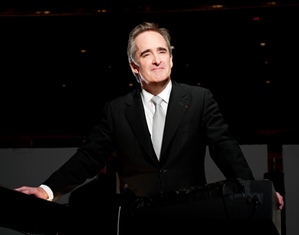
James Conlon, Arts Advocate, part II
(In part one of this
story, May Festival music director James Conlon spoke of his activity as a
writer and advocate for music and the arts, with a special focus on how to
compensate for the absence of music education in the schools. In part two, he
discusses other avenues for building audiences.)

With the dearth of music education in the schools today, particularly in the primary grades, building the audience for classical music is of great concern. One way is by utilizing multi-media. “The (video) screens at the Ravinia Festival, at first it was an experiment,” said Conlon, who has been music director at Ravinia since 2005. “The old guard didn’t like it, but we’ve found now that we can’t not do it anymore, because people like it.
The art shows presented at the May Festival are another example, as with Berlioz’ “L’enfance du Christ” and “Romeo and Juliet” (2007 and 2008) and Bach’s “St. Matthew Passion” (2010), where images of great art were projected onto a screen above the stage during the performance. “Everybody loved ‘L’enfance du Christ,’ and most people loved ‘Romeo and Juliet.’ Some people didn’t like Bach because they don’t need it. So there you guess. There’s great fear of Bach -- not by people who know and love it, but people who go, ‘Oh, it’s long and slow,’ so we took a chance. It’s a little harder to run a slide show against an absolute masterpiece like the ‘Matthew Passion.’ Did it bring the experience down or up? We probably brought it down for some people, whereas something like ‘L’enfance du Christ,’ which people are unfamiliar with, benefited from it. You’ll get it right sometimes and you’ll get it wrong other times.”
New music, perceived by some as a route to creating new audiences, is “a hard question and a highly politicized one,” said Conlon. “It has yet to be proven that new music makes new audiences in classical music. It’s a theory and there are two viewpoints. There is the ideological one, which is that it’s the right idea. Artists, the press in general, institutions, we all agree that it’s the right idea. Playing devil’s advocate, you look at the statistics and they don’t bear up. What you do about it becomes again a measure of your ideological point of view: You just continue to insist on it, or the other ideological universe, which is ‘no one’s coming to it, so why are you spending our shortened budgets on it?’”
As far as the Cincinnati May Festival goes, the issue is “preserving something that has basically disappeared from American life, which is the centrality of choral repertory. Has it disappeared? No. It doesn’t mean you won’t hear the Mozart Requiem in New York or the Mahler 8th Symphony in Chicago. What it does mean is that there is nothing like the May Festival, where there is a concentration for a two-week period on an art form, which is great choral classical music.”
Conlon, who will celebrate his 35th year as May Festival music director next season and has just renewed his contract through 2016, resists changing the festival to increase the audience. “Change it into a pops festival? Change into crossover? No. Occasionally do something crossover? Maybe, but not the core of the festival. Our mission is not to be a pops festival. Our mission is to be what classical choral music is.”
This is what attracted Conlon to Cincinnati in the first place. “James Levine recommended me to the board and the festival to me. He said, ‘look, you’ll be able to do all this repertory.’ The fact is that as a music director for any major symphony orchestra you would not do the quantity of choral music we do in two weeks here in an entire season – not meaning it would take you a season to do it, but you just wouldn’t do it. You would do one or two.’”
Conlon’s love for choral music and the opportunity to perform it at May Festival is the “great artistic attraction” for him, said Conlon, “but it went way beyond that years ago. It became a sense of connection with the people of Cincinnati, with the orchestra, the chorus, the hall, with the tradition of coming here every May. It is so much a part of my life and has been from almost the beginning of my professional life. I basically had been out in my professional career for five years before I came here. I barely can conceive of my life without it.”
James Conlon leads the May Festival Chorus and the Cincinnati Symphony Orchestra in the final weekend of the 2013 Cincinnati May Festival at 8 p.m. Friday and Saturday at Music Hall. Friday’s program comprises Stravinsky’s oratorio “Oedipus Rex,” Debussy’s “The Blessed Damozel” and “Sirènes” from “Nocturnes” and Ravel’s “Daphnis et Chloé” Suite No. 2. On Saturday, hear choruses and scenes from operas by Richard Wagner (“Lohengrin,” “Tannhäuser,” “Die Walküre,” “Die Meistersinger”) and Giuseppe Verdi (“Aida,” “Nabucco,” “Macbeth,” “Otello,” “I vespri siciliani”). Information and tickets at www.mayfestival.com